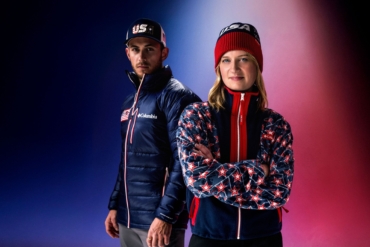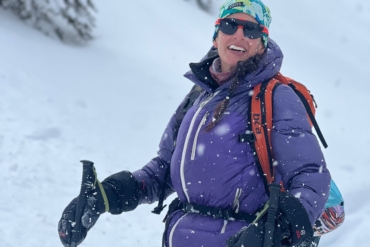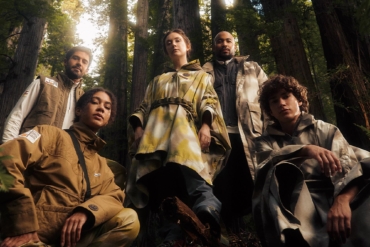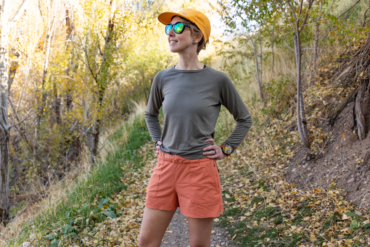Editor’s note: Sadly, mountaineer David Lama died just 3 weeks after the publication of this article in an avalanche in Canada, along with two other athletes. GearJunkie offers its condolences to the family and friends of Lama, Jess Roskelley, and Hansjorg Auer.
The North Face announced FUTURELIGHT fabric with bombastic fanfare at the start of this year. It made bold claims about changing the state of waterproof-breathable fabrics. But is it really the future of jackets, or is FUTURELIGHT just marketing hype? We put it to the test to find out.
I’m 4 hours into a backcountry ascent. It’s noon in Colorado, a Tuesday in March, and I’m following in the tracks of a famous mountaineer.

We’re in the Elk Mountains above Aspen, skinning up Hayden Peak. David Lama wears a fabric his sponsor, The North Face, touts as the current apex in outerwear design.
At 13,000 feet, Lama stops and looks back. I’m huffing in his tracks, my heart rate high, hot under the spring sun.
The North Face brought me here. The siren song was FUTURELIGHT, an all-caps material name for a membrane and fabric made to rival Gore-Tex as the best waterproof-breathable material on Earth.
“For the past couple decades, we have worn apparel we need to adapt to,” said Scott Mellin, global GM of The North Face’s Mountain Sports division. “Now, we have apparel that adapts to us.”
That’s a big claim. So I traveled to Aspen to dress in the same yellow jacket as Lama, and to follow him and guides from Aspen Expeditions on backcountry missions for two days. My goal? To learn if FUTURELIGHT really is, as the brand puts it, “the most advanced breathable waterproof technology in the world.”

In short: FUTURELIGHT fabric delivered a very breathable shell that works well for backcountry skiing. (I tested the men’s Summit L5 LT jacket.) It’s comfortable, blocks wind and precipitation, and allows moisture to escape as well as anything on the market. But it falls just short of “holy grail” status, as the jacket does trap some moisture when you redline and sweat.
An important aside: As this is an early review (the products come to market in 6 months), TNF required that we did not third-party test this jacket.
The North Face FUTURELIGHT: Coming Fall 2019
The Aspen trip was the first test of a line that releases this fall in 30-plus products. FUTURELIGHT will be used in high-end hardshell jackets, shell pants, gloves, and tents.

FUTURELIGHT is a harbinger to what TNF notes is a massive move “outside the supply chain.” The company spent millions to veer away from the available options and toward proprietary materials that could better distinguish the brand.
In high-end outerwear, rarely do companies pivot from Gore-Tex, Polartec, or the available pipeline of fabrics and components readymade for designing and putting a jacket to market.
But FUTURELIGHT is a tear-off-the-Band-Aid moment for TNF, which, like all the leaders in this space, has long been reliant on the same choices, factories, and specs as other brands. Thus, many brands are mired in a sea of sameness that performance outerwear has become.
FUTURELIGHT Jacket Review in Colorado
I traveled to Aspen, Colo., for an exclusive review. Over 3 days, I skied two major backcountry peaks — up and down — and extensively interviewed Mellin and other The North Face representatives about FUTURELIGHT.
Is it really the future of jackets? Or is it just more marketing fluff in a space already too worn with qualitative claims and mediocre real-world results?

To be sure, FUTURELIGHT is impressive, though not perfect. It protected my body for the whole of 2 days in the mountains — I never took the shell off through a range of temperatures, wind, sun, and varying levels of physical effort on the descents and climbs.
The jacket handled my exertion on Hayden Peak. The day was diverse, and a valid test of the material — from a trailhead start at about 9,000 feet (25 degrees F) to slipping into the shady trees with skins on, heading uphill, continuing into the alpine zone, and back to the intense sun.
The wind picked up near the summit, above 13,500 feet. We took off skis to traverse, a final posthole trek across the summit after hours of climbing. I followed David Lama across the ridge.
And the entire time, I had the FUTURELIGHT shell on and zipped up.
The North Face FUTURELIGHT Review
In short, I put FUTURELIGHT through its paces for 2 days. It performed better than anything similar I’ve worn in this kind of scenario.

I hardly knew I had the jacket on, which is high praise for a category associated with stiff collars and the swishing noise of friction from stiff fabric as you move. The men’s Summit L5 LT jacket is thin, stretchy, and as comfortable as a shell can be.
To be sure, it can’t handle high exertion in warm temps. But nothing we’ve tested in this category can. At the end of the day, my base layer top — a long-sleeve FlashDry synthetic by The North Face — was wet with sweat.
This was after hours of movement in the Aspen backcountry. It was hot by day’s end — in the 40s, with slushy snow underfoot — and FUTURELIGHT was pushed past its limit in the spring sun.
Never Take Off Your Shell Jacket?
But all day I’d hardly noticed any sweat or the shell jacket itself on my frame. And I’m usually averse to “hardshell”-type jackets for activities where my heart rate might spike.
We had climbed Hayden and then skied the Northwest Couloir. The classic line had been little-skied this season because of avalanche danger.
The jacket did its job quietly for hours as I climbed and huffed to keep up with Lama, guide Scott Eden from Aspen Expeditions, and the rest of our small crew.
TNF Summit L5 LT Jacket
The Summit L5 LT is a top-end piece with a price of $450. It’d better work at that MSRP. The light, supple, minimal shell is made of polyester and with few features. It’s a three-layer-construction jacket: two thin fabrics with a membrane in the middle.
Some of the common specs in the category are thin still on FUTURELIGHT. The North Face is guarded, not wanting to release some details until it brings the fabric to market this fall.

But we know the fabric comes in multiple thicknesses and types, and that the membrane is a nano-spun polyurethane. To “nanospin” FUTURELIGHT, 220,000 tiny nozzles spray a superthin matrix of the polymer.
The resulting grid has holes small enough for air permeability and breathability, though sized to keep moisture (rain, sleet) from seeping through. This is the same general premise Gore-Tex has used since the 1970s. But FUTURELIGHT is (as the name says) lighter, and it’s also more breathable in the mountains or the lab, Mellin promises.
The North Face created five different weights of the membrane and many fabric types for the line. This allows the brand to “tune” a jacket’s (or glove’s, or tent’s) breathability.
TNF’s eco story is similarly impressive. The company notes all fabrics use recycled materials. It adds a PFC-free DWR treatment to the face to make water bead and run off.
As we noted in an initial article on FUTURELIGHT, the moisture vapor transmission rate (MVTR) is 75,000 g/m²/day. For context, the highly breathable eVent fabric has a top MVTR of 30,000 g/m²/day.
FUTURELIGHT allows air to move through at a rate of about 1.5 ft³/minute — very permeable for a waterproof fabric. Again, for context, eVent’s most breathable fabric has a permeability of 0.2 ft³/minute, and many waterproof-breathable fabrics are lower, in the range of 0.07 to 0.09 ft³/minute.
But You’ll Probably Still Sweat
Even with its impressive spec, FUTURELIGHT can’t disperse sweat quick enough from the skin in extreme exertion. Nothing on the market currently can. But it’s not a be-all-end-all, Mellin said.

That’s not the message with version 1.0, at least. This is the first step toward an ultimate jacket, one that can maintain waterproofness and also regulate any human condition — sweat, heat, and all — from the inside out.
Mellin has been on the FUTURELIGHT project from day one. He initiated the idea of a better waterproof-breathable fabric after a day in the backcountry in 2017 with athlete Andres Marin.
“We wondered: Why couldn’t we wear a shell all day, never taking it off?” Mellin recalled. “Andres pushed me to think outside the current paradigm, and I then challenged our internal teams with the same theme.”
Is Nanospinning Really New?
There have been a few other attempts at somewhat similar products in recent years. Notably, Outdoor Research launched an electrospun membrane in the 2018 Interstellar Jacket. Polartec NeoShell is another similar membrane construction.
But Mellin confirmed to GearJunkie that FUTURELIGHT, though born of a process similar to other competing waterproof-breathable membranes, is a new, unique format. It’s manufactured in Korea outside of Seoul. TNF worked with a factory that makes insulating elements for electronics. It created new machines to develop a new kind of membrane that would slip into the fabric workflow.
The resulting product, the FUTURELIGHT membrane, looks like a white, stretchy film. It is so porous as to be actually 85 percent air.
FUTURELIGHT vs. NeoShell or AscentShell
I asked Mellin to compare FUTURELIGHT with Polartec’s NeoShell or Outdoor Research’s AscentShell. He had no comment. Mellin said TNF would release more test data this fall, at which point some of the lab-generated specs can be compared for anyone interested in the membrane wars.
But on the mountain, MTVR, CFM (ft³/minute), and other stats are not top of mind. My yellow Summit L5 LT Jacket was comfortable and nicely made. It was thin and supple, quieter than any hardshell in my closet. And after snagging it on trees a dozen times with no abrasions or rips, I could see the thin fabric was durable as well.
Water beads on the face. It was waterproof in my test, though sunny skies and wind in Colorado prevented a full “rain test” of FUTURELIGHT.

The jacket is also air-permeable to a large degree. This is wonderful when you’re sweating on a sunny climb. But exposed on the summit of Hayden, with wind tearing at 13,000 feet, the thin shell lets some air pass in. For extreme cold, you may want more protection than a minimal mountain shell.
Different FUTURELIGHT jackets offer more protection. TNF increases the membrane density and weight for different applications, including thicker plies for skiing jackets and tents, and thinner, extra-breathable applications for running shells.
Beyond the membrane, other components make FUTURELIGHT unique, Mellin said. First is a new kind of seam tape that is smaller, thinner, and more stretchy. The North Face also developed its own yarn and weaving processes, as well as new lamination and finishing techniques.
It took 2 years of R&D to bring FUTURELIGHT to market. The company has tested it across the world with its athletes and to the summit of Mount Everest.
I gave it a good go last month in Aspen and will continue to test the jackets as the rain falls this spring. So far, FUTURELIGHT has impressed. It’s a refined product line and a brave commitment by a brand that has stepped outside a paradigm to seek something better and new.








